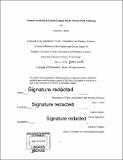| dc.contributor.advisor | Andrew Babbin. | en_US |
| dc.contributor.author | Boles, Elisabeth L | en_US |
| dc.contributor.other | Massachusetts Institute of Technology. Department of Earth, Atmospheric, and Planetary Sciences. | en_US |
| dc.coverage.spatial | p------ | en_US |
| dc.date.accessioned | 2018-09-18T15:43:35Z | |
| dc.date.available | 2018-09-18T15:43:35Z | |
| dc.date.copyright | 2018 | en_US |
| dc.date.issued | 2018 | en_US |
| dc.identifier.uri | http://hdl.handle.net/1721.1/118132 | |
| dc.description | Thesis: S.B., Massachusetts Institute of Technology, Department of Earth, Atmospheric, and Planetary Sciences, 2018. | en_US |
| dc.description | Cataloged from PDF version of thesis. | en_US |
| dc.description | Includes bibliographical references (pages 45-47). | en_US |
| dc.description.abstract | Nitrous oxide (N2O) is a powerful greenhouse gas and ozone depleting substance, but its natural sources remain poorly constrained. Marine emissions are likely much higher than IPCC estimates predict, due to unusually high emissions from the oxygen minimum zones (OMZs) in the eastern tropical Pacific and Arabian Sea that are not accounted for in assessments. Measurements of atmospheric concentrations from a selection of AGAGE stations around the Pacific Ocean were combined with back-trajectories calculated using the HYSPLIT4 atmospheric model, in order to study the relative importance of OMZs on Pacific N2O emissions. Spatial and temporal variability in nitrous oxide concentrations were analyzed in order to determine potential regions of higher emissions, as well as the impacts of ENSO on biogeochemistry in the OMZs. Air parcels that passed over the oxygen minimum zone in the Eastern Tropical South Pacific were found to have N2O concentrations as much as 0.5 ppb higher than average. Average concentrations over the OMZ were modulated by an additional ~0.2 ppb higher during La Niia events and ~0.2 ppb lower during El Niio periods, a deviation of the same order of magnitude as N2O's seasonal cycle. Comparisons with CFC-12 and SF6 suggested strong influences on nitrous oxide concentrations in the Southern Hemisphere from stratosphere-troposphere exchange, but little influence from inter-hemispheric transport. | en_US |
| dc.description.statementofresponsibility | by Elisabeth L. Boles. | en_US |
| dc.format.extent | 47 pages | en_US |
| dc.language.iso | eng | en_US |
| dc.publisher | Massachusetts Institute of Technology | en_US |
| dc.rights | MIT theses are protected by copyright. They may be viewed, downloaded, or printed from this source but further reproduction or distribution in any format is prohibited without written permission. | en_US |
| dc.rights.uri | http://dspace.mit.edu/handle/1721.1/7582 | en_US |
| dc.subject | Earth, Atmospheric, and Planetary Sciences. | en_US |
| dc.title | Natural variability in eastern tropical Pacific nitrous oxide emissions | en_US |
| dc.type | Thesis | en_US |
| dc.description.degree | S.B. | en_US |
| dc.contributor.department | Massachusetts Institute of Technology. Department of Earth, Atmospheric, and Planetary Sciences | |
| dc.identifier.oclc | 1051221754 | en_US |
